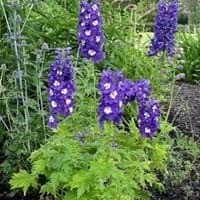Life Span
Biennial and Perennial
Perennial
Type
Vegetable
Flowering Plants, Ornamental Plants, Shrubs
Origin
Europe, Western Asia
Africa
Types
Not Available
Not Available
Number of Varieties
Not Available
Habitat
waste ground, wastelands
gardens, meadows
USDA Hardiness Zone
4-9
Not Available
Sunset Zone
A1, A2, A3, H1, H2, 1a, 1b, 2a, 2b, 3a, 3b, 4, 5, 6, 7, 8, 9, 10, 11, 12, 13, 14, 15, 16, 17, 18, 19, 20, 21, 22, 23, 24
Not Available
Habit
Rosette/Stemless
Upright/Erect
Minimum Width
Not Available
Flower Color
Yellow
Blue, Indigo, Lavender, Light Purple
Flower Color Modifier
Bicolor
Bicolor
Fruit Color
Brown, Black
Not Available
Leaf Color in Spring
Green
Green
Leaf Color in Summer
Green
Light Green
Leaf Color in Fall
Green
Green, Yellow green
Leaf Color in Winter
Not Available
Green, Light Yellow, Tan
Leaf Shape
Pinnate
Palmate and toothed
Plant Season
Summer
Spring, Summer, Fall, Winter
Sunlight
Full Sun
Full Sun, Partial Sun
Type of Soil
Loam
Clay, Loam, Sand
The pH of Soil
Neutral
Acidic, Neutral, Alkaline
Soil Drainage
Well drained
Well drained
Bloom Time
Summer
Not Available
Tolerances
Drought
Heat And Humidity
Where to Plant?
Ground, Pot
Ground, Pot
How to Plant?
Seedlings
Seedlings, Stem Cutting
Plant Maintenance
Medium
Medium
Watering Requirements
Average Water Needs, Do Not over Water, Keep the ground moist but not water-logged
It cannot sustain wet-feet, Keep ground moist, Requires regular watering, Water more in summer
In Summer
Lots of watering
Lots of watering
In Spring
Moderate
Moderate
In Winter
Average Water
Average Water
Soil pH
Neutral
Acidic, Neutral, Alkaline
Soil Type
Loam
Clay, Loam, Sand
Soil Drainage Capacity
Well drained
Well drained
Sun Exposure
Full Sun
Full Sun, Partial Sun
Pruning
Remove damaged leaves, Remove dead branches, Remove dead leaves
Cut away fading foliage, Do not prune during shooting season, Remove damaged leaves, Remove deadheads
Fertilizers
All-Purpose Liquid Fertilizer
High-phosphorous fertilizers used, Organic Flower Fertilizer
Pests and Diseases
Aphids, Armyworm, Cutworms, Downy mildew, Pitch canker, Red blotch
Bacterial leaf spot, fungus, Mealybugs
Plant Tolerance
Drought
Heat And Humidity
Flower Petal Number
Not Available
Single
Fragrant Bark/Stem
Yes
No
Foliage Texture
Fine
Fine
Foliage Sheen
Matte
Matte
Attracts
Butterflies
Butterflies
Allergy
Stomach burn
Severe allergen, Skin irritation, Skin rash, Throat itching, Vomiting
Aesthetic Uses
Not Available
Beautification, Borders, Showy Purposes, Used for decorating walls, fences, gates, hedges, etc.
Beauty Benefits
Blood purifying, Good for skin
Not Available
Environmental Uses
Air purification
Air purification
Medicinal Uses
Aphrodisiac
Not Available
Part of Plant Used
Root
Flowers
Other Uses
Food for animals, Used as a nutritious food item
Used in making blue ink
Used As Indoor Plant
Yes
No
Used As Outdoor Plant
Yes
Yes
Garden Design
Edible, Herb, Vegetable
Edging, Feature Plant
Botanical Name
PASTINACA sativa
Delphinium elatum
Common Name
Parsnip
Alpine delphinium, Delphium, Candle larkspur, Siberian larkspur, Musk Larkspur,
In Hindi
चुकंदर
अल्पाइन Delphinium
In German
Pastinake
Alpine Delphinium
In French
Panais
Alpine Delphinium
In Spanish
Chirivía
Alpine Delphinium
In Greek
Είδος δαυκίου
Alpine Δελφίνιο
In Portuguese
cherivia
Alpine Delphinium
In Polish
Pasternak
Alpine Delphinium
In Latin
parsnip
Alpine Delphinium
Phylum
Magnoliophyta
Tracheophyta
Class
Magnoliopsida
Magnoliopsida
Order
Apiales
Ranunculales
Family
Apiaceae
Ranunculaceae
Clade
Angiosperms, Asterids, Eudicots
Angiosperms, Eudicots
Tribe
Not Available
Not Available
Subfamily
Not Available
Not Available
Number of Species
Not Available
Season and Care of Parsnip and Alpine Delphinium
Season and care of Parsnip and Alpine Delphinium is important to know. While considering everything about Parsnip and Alpine Delphinium Care, growing season is an essential factor. Parsnip season is Summer and Alpine Delphinium season is Summer. The type of soil for Parsnip is Loam and for Alpine Delphinium is Clay, Loam, Sand while the PH of soil for Parsnip is Neutral and for Alpine Delphinium is Acidic, Neutral, Alkaline.
Parsnip and Alpine Delphinium Physical Information
Parsnip and Alpine Delphinium physical information is very important for comparison. Parsnip height is 15.20 cm and width 7.60 cm whereas Alpine Delphinium height is 200.00 cm and width Not Available. The color specification of Parsnip and Alpine Delphinium are as follows:
Parsnip flower color: Yellow
Parsnip leaf color: Green
Alpine Delphinium flower color: Blue, Indigo, Lavender and Light Purple
- Alpine Delphinium leaf color: Green
Care of Parsnip and Alpine Delphinium
Care of Parsnip and Alpine Delphinium include pruning, fertilizers, watering etc. Parsnip pruning is done Remove damaged leaves, Remove dead branches and Remove dead leaves and Alpine Delphinium pruning is done Cut away fading foliage, Do not prune during shooting season, Remove damaged leaves and Remove deadheads. In summer Parsnip needs Lots of watering and in winter, it needs Average Water. Whereas, in summer Alpine Delphinium needs Lots of watering and in winter, it needs Average Water.





